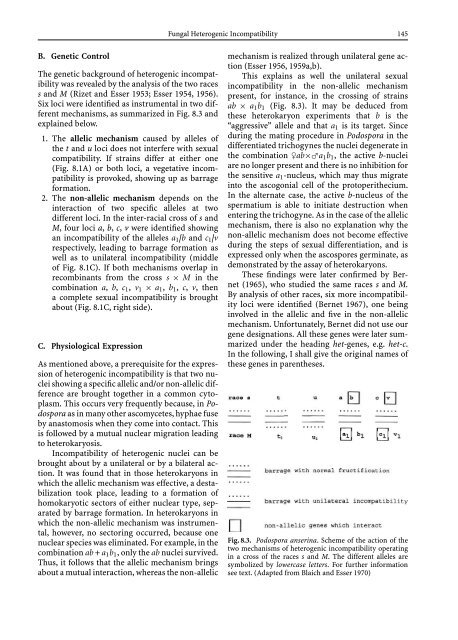Growth, Differentiation and Sexuality
Growth, Differentiation and Sexuality
Growth, Differentiation and Sexuality
Create successful ePaper yourself
Turn your PDF publications into a flip-book with our unique Google optimized e-Paper software.
B. Genetic Control<br />
The genetic background of heterogenic incompatibility<br />
was revealed by the analysis of the two races<br />
s <strong>and</strong> M (Rizet <strong>and</strong> Esser 1953; Esser 1954, 1956).<br />
Six loci were identified as instrumental in two different<br />
mechanisms, as summarized in Fig. 8.3 <strong>and</strong><br />
explained below.<br />
1. The allelic mechanism caused by alleles of<br />
the t <strong>and</strong> u loci does not interfere with sexual<br />
compatibility. If strains differ at either one<br />
(Fig. 8.1A) or both loci, a vegetative incompatibility<br />
is provoked, showing up as barrage<br />
formation.<br />
2. The non-allelic mechanism depends on the<br />
interaction of two specific alleles at two<br />
different loci. In the inter-racial cross of s <strong>and</strong><br />
M, fourlocia, b, c, v were identified showing<br />
an incompatibility of the alleles a1|b <strong>and</strong> c1|v<br />
respectively, leading to barrage formation as<br />
well as to unilateral incompatibility (middle<br />
of Fig. 8.1C). If both mechanisms overlap in<br />
recombinants from the cross s × M in the<br />
combination a, b, c1, v1 × a1, b1, c, v, then<br />
a complete sexual incompatibility is brought<br />
about (Fig. 8.1C, right side).<br />
C. Physiological Expression<br />
As mentioned above, a prerequisite for the expression<br />
of heterogenic incompatibility is that two nuclei<br />
showing a specific allelic <strong>and</strong>/or non-allelic difference<br />
are brought together in a common cytoplasm.<br />
This occurs very frequently because, in Podospora<br />
as in many other ascomycetes, hyphae fuse<br />
by anastomosis when they come into contact. This<br />
is followed by a mutual nuclear migration leading<br />
to heterokaryosis.<br />
Incompatibility of heterogenic nuclei can be<br />
brought about by a unilateral or by a bilateral action.<br />
It was found that in those heterokaryons in<br />
which the allelic mechanism was effective, a destabilization<br />
took place, leading to a formation of<br />
homokaryotic sectors of either nuclear type, separated<br />
by barrage formation. In heterokaryons in<br />
which the non-allelic mechanism was instrumental,<br />
however, no sectoring occurred, because one<br />
nuclear species was eliminated. For example, in the<br />
combination ab + a1b1,onlytheab nuclei survived.<br />
Thus, it follows that the allelic mechanism brings<br />
about a mutual interaction, whereas the non-allelic<br />
Fungal Heterogenic Incompatibility 145<br />
mechanism is realized through unilateral gene action<br />
(Esser 1956, 1959a,b).<br />
This explains as well the unilateral sexual<br />
incompatibility in the non-allelic mechanism<br />
present, for instance, in the crossing of strains<br />
ab × a1b1 (Fig. 8.3). It may be deduced from<br />
these heterokaryon experiments that b is the<br />
“aggressive” allele <strong>and</strong> that a1 is its target. Since<br />
during the mating procedure in Podospora in the<br />
differentiated trichogynes the nuclei degenerate in<br />
the combination ♀ab×♂a1b1, theactiveb-nuclei<br />
are no longer present <strong>and</strong> there is no inhibition for<br />
the sensitive a1-nucleus, which may thus migrate<br />
into the ascogonial cell of the protoperithecium.<br />
In the alternate case, the active b-nucleus of the<br />
spermatium is able to initiate destruction when<br />
entering the trichogyne. As in the case of the allelic<br />
mechanism, there is also no explanation why the<br />
non-allelic mechanism does not become effective<br />
during the steps of sexual differentiation, <strong>and</strong> is<br />
expressed only when the ascospores germinate, as<br />
demonstrated by the assay of heterokaryons.<br />
These findings were later confirmed by Bernet<br />
(1965), who studied the same races s <strong>and</strong> M.<br />
By analysis of other races, six more incompatibility<br />
loci were identified (Bernet 1967), one being<br />
involved in the allelic <strong>and</strong> five in the non-allelic<br />
mechanism. Unfortunately, Bernet did not use our<br />
gene designations. All these genes were later summarized<br />
under the heading het-genes, e.g. het-c.<br />
Inthefollowing,Ishallgivetheoriginalnamesof<br />
these genes in parentheses.<br />
Fig. 8.3. Podospora anserina. Scheme of the action of the<br />
two mechanisms of heterogenic incompatibility operating<br />
in a cross of the races s <strong>and</strong> M. The different alleles are<br />
symbolized by lowercase letters. For further information<br />
see text. (Adapted from Blaich <strong>and</strong> Esser 1970)

















